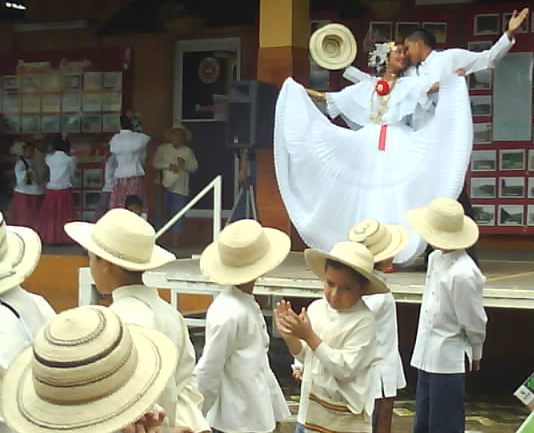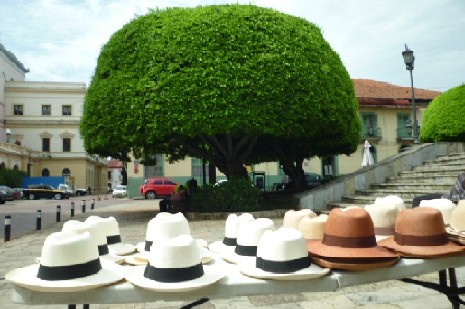Panama (South)
Taking things for granted never works in the long run. I got a three month visa for Panama at the border and asked for three months insurance for the motorbike and as the woman in the insurance office didnt say anything I assumed thats what I was given. I then presented the insurance certificate to customs to get the temporary import licence for the motorbike and assumed the bike was valid for three months. In all the previous countries on this trip the bike permit has always been for the same duration as my visa which has a nice symmetry and what is the point of getting a visa and bike permit for different durations? However that is what they do in Panama (and Egypt apparently). From now on I will be doing more research before getting to each border and reading the documents as I get them until I no doubt eventually lapse into taking things for granted again! I was talking to a group of travellers over coffee who mentioned that vehicle permits were only valid for one month. I argued that I had been given three months but on checking later on I discovered I had indeed only been given one months motorcycle permit and that was one month and two days ago. It was the weekend and there was nothing I could do until Monday morning when I presented myself at an insurance office as it opened at 8am. The plan was to pick up another months insurance then not wanting to use the bike without its permit, get the bus to David City which had the nearest customs office to apply for an extension to the bike permit. At the insurance office I was told to return at 4pm to collect the certificate so that was another day gone. Bright and early the next morning I was on the bus to David then took a taxi to the customs office. I wasnt expecting too many problems other than the usual slow form filling and waiting as the bureaucratic wheels slowly turn, possibly a small fine to pay for the lapsed vehicle permit and a small fee for extending the permit by a month. What I experienced was a farcical morning having to bribe a corrupt customs officer of the Republic of Panama.

Boquete River, Panama
I was happy to go through the official process but that optioned wasnt offered. At the desk the customs officer was furtively glancing around the room as we attempted a whispered conversation in Spanish. He even used Google Translate to print out a sentence, show it to me then put it through the shredder, sadly like most Google Translate sentences it didn't make any sense. Other people came into the office, got processed and left as I was still hanging around. I suspect I would have been processed more quickly and cheaply if the officer had done the paperwork officially. Eventually he typed out a new permit making it look like I had arrived in Panama that day and valid for a month which is fine providing no one inspects the permit and passport together because the passport shows me entering at a different border crossing on a different date. After waiting for ages until there was no one else in the office he surreptitiously slipped the new permit into my bag and moved it closer to the wall to conceal me passing across $20. If there are no more blog entries after this one assume the dodgy paperwork was discovered and that Im now languishing in some sinister jail sharing a cell with a group of gringo hating habitual criminals.

Traditional Panamanian Dancing
Sadly, the powers that be still havent got round to building a road between the North and South American continents. In an area known as the Darien Gap there is a straight line distance of about 90km (56 miles) of jungle, swamp, rivers and mountains without a road. Fewer people have crossed the Darien Gap than have been to the North or South Pole. It has a reputation for lawlessness and is now considered too dangerous to allow anyone to attempt the crossing. The first all-land auto crossing was in 19851987 by Loren Upton and Patty Mercier, they took 741 days to travel 201km (125 miles) in a CJ-5 Jeep. Thats an average of the length of three football fields per day! Upton returned in 1995 and became the first to drive a motorcycle, a two-wheel drive Rokon, all on land through the Darién Gap, in 49 days. A few others have done crossings by riding between rivers then transferring into canoes. The twin arguments for not building the road are the environmental argument for maintaining one of the few untouched, natural parts of the world which I have some sympathy with. The second reason is that the USA doesnt want a road building as it is concerned that it will aid the transportation of drugs into the States. Im not sure that I agree with the USA as the drugs arrive anyway and I would think it is easier to police a road than the oceans and sky but I will readily concede that the government of the USA has probably completed a more in-depth study into the problem than I have.

Panama Hats
As I travel more slowly than anyone else I have met on my trip I have been able to get up to date advice on the various options for getting from Panama to Colombia from riders who have overtaken me and are now dotted around South America. I decided on sailing from San Blas to Cartagena on the Stahlratte (German for Steel Rat), a 125 foot (38.5 metres) long steel hulled sailing boat built in 1903. At $820 for me and the motorbike that works out at an expensive $14.64 (£9.66) per mile based on the land distance without a road but we will be sailing considerably further than that. The crossing takes five days with stops at various San Blas islands in the Caribbean. Having booked my passage I now have to pace my trip to arrive in Carti on the San Blas coast in time to board the boat.

I Think This Sign Means 'BRACE FOR IMPACT'
Heading south (east) on the Pan Americana Highway towards Santiago there were three police checkpoints and I was flagged down at each of them. This has become routine and I havent experienced any problems, they see a foreign registered motorcycle as a bit of a novelty and are interested in where youre going, how much your bike cost and which soccer team you support. I overtook a slow moving truck on a long straight section of road crossing the double yellow lane markers as I did so. The manoeuvre was perfectly safe but technically a little bit illegal and of course there was a police checkpoint further up the road to witness it. Our discussion included illegal overtaking and the soccer teams of Liverpool, Manchester United, Newcastle United and Barcelona, fortunately; my apology for supporting Newcastle United and crossing the double yellow line was accepted. A bit further along the Pan Americana I was overtaking a bus, legally this time, crossing back onto my side of the road before the lane markings changed so that oncoming traffic had the right to overtake. Again there was a police checkpoint further ahead and this time I was told that I was in big trouble for overtaking illegally. I have found it prudent when confronted with someone holding a gun to agree wholeheartedly with everything that they say so clearly I was mistaken about the lane markings. I was told that I would have to go to court in Panama City to pay a fine of over $100, we agreed that this was mucho problema so the police officer kindly suggested I could pay an on the spot fine of $40. I counter offered that a fine of $20 would be less painful and although his gun gave him the final word he agreed. For some reason that wasnt explained the officer wanted to wait until the road was clear of witnesses before I paid the fine and then he forgot to give me a receipt. I continued the rest of the journey following the trucks and buses, not daring to venture anywhere near the centre of the road regardless of the lane markings. I have only had to pay bribes twice on the trip so far, both in Panama although I think this has more to do with the luck of the draw rather than Panama being more corrupt than other Central American countries.

My Santa Fe Home
I went to Santa Fe as it was the last opportunity to spend time in the mountains until I get to Colombia. Santa Fe was cooler than the coast and the best place to wait until closer to the date for sailing to Colombia although I got a few strange looks when I explained that I was waiting for a boat so far from the sea. I wanted to spend a few days in Panama City before riding to Carti to board the Stahlratte. The Santa Fe hostel was run by keen gardeners and I spent a fair bit of each day lying in a hammock reading in the garden. The hiking trails were all awash with mud so I left them to the hardier, younger travellers and stuck to walking on the paved roads around town and down to the river.

The Bridge Of The Americas Over The Panama Canal
The Bridge Of The Americas made an impressive entrance into Panama City prior to circling my booked hostel a couple of times trying to find the way through all the one way streets. After getting the bike parked in the back garden I headed towards the high rise buildings downtown which reminded me a bit of Hong Kong with the variety of the building designs. The original Panama City was destroyed by the Welsh pirate Henry Morgan in 1671 but most of the cities wealth that he was after had been packed onto a ship before he arrived. The city was rebuilt nearby in an area now known as Casco Viejo which had been allowed to decline although the Panamanian government has now offered incentives to restore the area and a lot of the buildings are now undergoing restoration. There were are lot of armed police in the streets of Casco Viejo and some roads were cordoned off by police, I later found out that these streets led to the Panamanian Presidents house.

Panama City Skyline

Colonial Casco Viejo, Panama City
There are two sets of locks in the Panama canal, one at either end lifting the boats above sea level to the height of the Gatun Lake that ships navigate through and then lowering them down again at the other end. The Miraflores locks at the Pacific end of the canal are a short distance from Panama City, a group of us decided to take a taxi rather than trying to navigate through the city traffic. We saw a large merchant ship come through followed by a smaller cruise ship with a catamaran tucked in behind it. I spoke to a couple who had brought their yacht through for $800, a bargain considering the alternative of sailing around South America. The biggest ships pay up to $400,000 for the eight hour crossing. New locks are under construction which are going to be much larger to cater for the bigger vessels being used now.

Cruise Ship In Panama Canal
